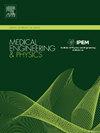Hemodynamic insight into the iliac vein after stent intervention: Mind the persistent compression of iliac vein stent
IF 1.7
4区 医学
Q3 ENGINEERING, BIOMEDICAL
引用次数: 0
Abstract
This study hypothesizes that lumbar spine and iliac artery compression of veins persists after stenting, rendering the iliac vein susceptible to restenosis, thrombosis, and other clinical complications. To examine this hypothesis, a vascular model post-iliac vein stenting was constructed based on vein images from patients with iliac vein compression syndrome. This model facilitated the examination of how varying degrees of compression affect the hemodynamic environment of the host vasculature post-stenting. Results indicated that while compression increased blood flow velocity near the affected area, it also led to a more disturbed blood flow environment within the stent segment, at bifurcation points, and in the contralateral iliac vein, as evidenced by elevated Oscillatory Shear Index (OSI) and Relative Residence Time (RRT) values. Furthermore, the study observed that while the implantation of long stents minimally impacted the blood vessels within the stent segment, it did marginally mitigate adverse blood flow conditions at intersections under compression. Consequently, the ongoing adverse effects of compression on the flow environment post-stenting, potentially linked to suboptimal postoperative outcomes at these sites, should be carefully considered.
支架介入后髂静脉血流动力学观察:注意髂静脉支架的持续压迫
本研究假设在支架植入后,腰椎和髂动脉对静脉的压迫持续存在,使髂静脉容易再狭窄、血栓形成和其他临床并发症。为了验证这一假设,我们基于髂静脉压迫综合征患者的静脉图像构建了髂静脉支架植入术后血管模型。该模型有助于检查不同程度的压迫如何影响支架植入后宿主血管的血流动力学环境。结果表明,压缩在增加病变区域附近血流速度的同时,也导致支架段内、分叉点和对侧髂静脉血流环境受到更大的干扰,振荡剪切指数(OSI)和相对停留时间(RRT)值升高。此外,该研究观察到,虽然植入长支架对支架段内血管的影响最小,但它确实轻微缓解了受压下交叉处的不良血流状况。因此,应仔细考虑支架植入后压迫对血流环境的持续不利影响,这可能与这些部位的次优术后结果有关。
本文章由计算机程序翻译,如有差异,请以英文原文为准。
求助全文
约1分钟内获得全文
求助全文
来源期刊

Medical Engineering & Physics
工程技术-工程:生物医学
CiteScore
4.30
自引率
4.50%
发文量
172
审稿时长
3.0 months
期刊介绍:
Medical Engineering & Physics provides a forum for the publication of the latest developments in biomedical engineering, and reflects the essential multidisciplinary nature of the subject. The journal publishes in-depth critical reviews, scientific papers and technical notes. Our focus encompasses the application of the basic principles of physics and engineering to the development of medical devices and technology, with the ultimate aim of producing improvements in the quality of health care.Topics covered include biomechanics, biomaterials, mechanobiology, rehabilitation engineering, biomedical signal processing and medical device development. Medical Engineering & Physics aims to keep both engineers and clinicians abreast of the latest applications of technology to health care.
 求助内容:
求助内容: 应助结果提醒方式:
应助结果提醒方式:


